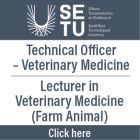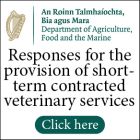Large animal - June 2019
Beef cattle reproductive management
It is strongly recommended that beef farmers should develop a specific breeding programme to produce high-quality stock. Federico Randi, global ruminants technical manager, Ceva Sante Animale, Libourne, France and Patrick Lonergan, School of Agriculture and Food Science, University College, Dublin, outline the reasons here
Introduction
Ireland’s suckler herd is worth approximately €3bn annually to the economy and accounts for the equivalent of 52,000 full-time jobs, both directly and indirectly. In contrast to the aims of successive government strategy documents (Food Harvest 2020, Food Wise 2025) to significantly increase dairy and beef output, a recent EU report on greenhouse gas (GHG) emissions suggests that Ireland should reduce its beef and dairy herds by 33% and 5%, respectively, in order to meet emissions targets for 2030. This would see the Irish beef herd contract to levels last seen in the 1980s leading to a 19% reduction in our beef production output. Therefore, strategies are required to increase reproductive/production system efficiency.
Herd fertility, or reproductive efficiency, is acknowledged worldwide as a key driver of the productive, economic and environmental sustainability of beef cow herds. However, industry statistics clearly show that, nationally, we are failing to meet key management targets consistent with economically and environmentally sustainable beef cow herds. For example, age at first calving, calving interval, annual calf output, low usage of elite genetics through artificial insemination (AI) and overall genetic progress are all well below par with implications for both the economic and environmental sustainability of the sector.
In beef cow herds, pregnancy has a four-times greater economic impact than any other production trait, yet how many producers select for pregnancy first? This conclusion comes from a series of studies conducted in the United States by the Beef Reproduction Task Force, but very similar conclusions could be drawn from an analysis of the European beef industry. To further emphasise this notion, it is worth remembering that, in contrast to the dairy industry where milk is the major output, the only economic output of a suckled beef cow, apart from her cull cow value, is a weaned calf.
Current reproductive management on beef farms
A recent meeting of representatives from different countries summarising the state of their respective national beef industries (Belgium, France, Ireland, Italy, South Africa, United Kingdom and the United States) produced a picture of a small average herd size for cow-calf enterprises, with approximately 35 cows per herd, where the Irish average herd size was reported to be fewer than 20 cows. For the majority of the countries involved, due to the moderate average herd size, the suckled herd enterprise is typically complementary to another income source and is mostly of a part-time nature.
The main reproductive target for a cow-calf operation in all systems of production is to produce a calf per cow per year, resulting in a calving interval of 365 days. According to the Irish Cattle Breeding Federation (ICBF) 2018 statistics, suckled cows have a calving interval of 396 days, 85% of cows produce a calf every year, and only 16% of calves are bred by artificial insemination (AI). With these figures in mind, it is clear that significant room for improvement exists (ICBF statistics, 2018).
Beef herds predominantly utilise pasture as a feeding source for cows and calves, and, for that, a seasonal pattern of births is a desirable trait. However, this is not always achieved at the farm level.
One strategy adopted by US producers, in an attempt to increase herd reproductive performance, is to extend the length of the breeding season. However, do long breeding seasons necessarily result in higher pregnancy rates? An examination of the records of 230 beef herds in Missouri, which included over 22,000 cows clearly demonstrate that longer breeding seasons do not increase overall pregnancy rate (Smith and Perry pers. comm).
One of the reasons that lengthening the breeding season does not increase pregnancy rate is that longer breeding seasons result in longer calving seasons. Cows that calve late frequently do not have adequate time to return to oestrus and conceive before the end of the breeding season, which can lead to further extension of the breeding period and a perpetuation of the problem. In fact, decreasing the length of the breeding season can actually increase reproductive performance and weaning weights by shortening the calving season and providing cows with more time to return to cyclicity by the start of the subsequent breeding season. This approach also leads to increased weaning weights due to increased calf age at weaning. Furthermore, a shorter calving season facilitates closer supervision at calving which can reduce calf mortality around birth, particularly in heifers.
The most frequently used breeding method in beef herds is natural mating with a stock bull. Under such conditions, bull management becomes the exclusive tool that farmers have for controlling calving spread and calf quality. Beef cattle practitioners must be proactively involved in breeding soundness evaluation and bull health management, something which is often overlooked by farmers who often assume that the bull is always a very effective breeding instrument. In recent years, the purchase cost of stock-bulls in the US as well as EU countries, has consistently increased while the price for AI straws and synchronisation programmes has remained unchanged for a decade.
When cows are bred by natural service, the serving capacity of the bull becomes a critical management consideration. While infertility is low among stock-bulls (≈5%), subfertility can occur in up to 15-20% of bulls; even if present as a transient condition, subfertility can have devastating impacts on herd fertility performance (Diskin and Kenny, 2016). Moreover, breeding capacities of stock-bulls are affected by age and bull:cow ratio, as well as the fact that the bull’s mating capacity is strongly related to the number of cows in heat at the same time.
Recommendations for bull:cow ratios for non-synchronised cows range from 1:10 to 1:50 with an average of 1:30. This range is strongly dependant on the age, experience and semen-quality of the bull, as well as size and terrain of the breeding pasture. In a large-scale study conducted by the University of California Davis, evaluating 5,025 calvings involving 275 sires, the breeding performance of bulls used was extremely variable and unpredictable. In those well-managed herds, a significant proportion of pregnancies were established in the first three weeks of the breeding season, involving cows that have resumed cyclicity before its start (on average 50% of cows in spring-calving systems: Stevenson et al, 2003 and Lucy et al, 2001). Only one-third of the bulls were capable of successfully impregnating a high proportion of cows. The remaining two-thirds of the bulls maintained the same level of pregnancies established across the entire season, incompatible with compact calving (Figure 1). In the study, due to the large herd sizes, multiple sires were available at the same time and each bull’s performance was diluted. Transferring the results achieved in this large field study to a European context, where in the majority of herds a single sire is typically present, a significant spread in calving would result.
The re-establishment of normal ovarian cyclicity post-partum is an important component of the calving interval. Parturition is followed by a period of ovarian quiescence and sexual inactivity before the resumption of normal cyclicity (Crowe et al, 2014). This is a natural mechanism that reduces the chances of a new pregnancy being established before the new-born has been weaned. Prolonged postpartum acyclicity in suckled beef cows is a source of economic loss to beef herds. The main factors impacting the length of this period are ‘suckling status’ or, more precisely, the mother-calf bond, nutritional status, and the season. A crucial difference exists between dairy cows and suckled beef cows in the post-partum period. In both categories, a transient follicle stimulating hormone (FSH) rise occurs on day three to day five, post-partum, and a dominant follicle is detectable by day seven to day 10. In the absence of pathological or metabolic conditions, most dairy cows ovulate the first postpartum dominant follicle around day 15 to day 20. In contrast, many beef cows exhibit a prolonged postpartum anoestrous period for the reasons mentioned above.
Luteinizing hormone pulse frequency requires a period of 10-20 days to be completely restored; this occurs physiologically in dairy cows and beef cows that are weaned after parturition. The GnRH/LH pulse frequency in the post-partum suckled cow instead is affected by the suppressive effect of the maternal-offspring bond. It acts at the hypothalamic level reducing GnRH secretion preventing the establishment of frequent LH pulses and a preovulatory LH surge, necessary for ovulation (Crowe et al, 2014).
In beef cows, a crucial element conditioning the length of the anovular post-partum period is the body condition score (BCS). In cows that calve in good BCS and do not experience severe negative energy balance after parturition, the first postpartum ovulation occurs around days 35-40. In comparison, cows in poor BCS require multiple follicular waves before ovulation occurs, 70-100 days on average (Stagg et al, 1995).
The first ovulation in both dairy and beef cows is, generally, silent (no behavioral oestrus) and is, generally (>70%), followed by a short cycle, with just one follicular wave. This first luteal phase is reduced in length due to the premature release of prostaglandin. The corpus luteum (CL) regresses at approximately days eight-10 of the cycle, with the second ovulation occurring at approximately days nine-11 after the first ovulation. After the exposure of hypothalamus-hypophysis axis of the cow to progesterone, from the short-lasting first CL, the following ovulation is associated with the expression of oestrus and a normal-length luteal phase (normal cyclicity is established).
Reproductive efficiency in many beef herds is challenged by several factors. Collection of information on the reproductive performance of national beef herds is complicated by the fact that data recording is not a common practice for many beef enterprises. The absence of data at farm level is an important barrier for farmers to make a full economical evaluation of their business. For instance, the cost of purchasing a stock-bull and its yearly maintenance is very rarely linked to the number of successful pregnancies established per season and the number of seasons which are needed to return the investment.
Frequently, farmers are reluctant to submit stock-bulls to an annual breeding soundness evaluation before the breeding season begins. This reluctance is driven by the perceived high cost of the test. However, they are occasionally obliged to purchase a second stock-bull late in the breeding season, after finding out that many cows have returned to oestrus, or are detected non-pregnant at the end of the season.
The use of genetic selection through AI and genomics in beef herds
The most efficient and economical method to facilitate genetic improvement is through AI with semen from genetically superior sires. The use of oestrous synchronisation remains the most important and widely applicable reproductive biotechnology to facilitate AI in beef cattle (Seidel, 1995, Baruselli et al, 2018). Due to the extensive nature of the productive system, for the vast majority of the countries, AI has strong barriers to implementation at farm level. As indicated in Figure 3, the labour involved in the application of reproductive management strategies is the biggest limiting factor for their acceptance at farm level. The main advantages of artificial insemination in beef herds include:
- Access to genetically high-quality terminal and maternal sires;
- Selection of easy-calving proven sires (to avoid the need for calving assistance and C-sections);
- The facility to mate cows and heifers to specific bulls (maintenance of hybrid vigour);
- Access to consistently high quality semen (overcomes the risks of infertility/subfertility of breeding bulls);
- Removal/reduction of hazards due to bulls;
- The capability to keep stock-bulls in the herd for longer, avoiding consanguinity (reduces the risks for a breeding bull to breed its own offspring, replacement heifers); and
- Improves biosecurity due to the limitation of entering of new animals (heifers, new bulls) and reduction of the spread of diseases through coitus.
The main limiting factor to a more widespread adoption of AI is the fact that in order to inseminate a cow, oestrus has to be detected. The optimal time to inseminate is highly correlated with a precise knowledge of the time of oestrus onset. This requires at least four to five visual observations of the herd per 24-hour period for 20 minutes each time, with the first and the last one performed early in the morning and late in the evening (Diskin and Sreenan, 2000). This can represent a real challenge in the reality of beef farming. Most of these businesses are predominantly part-time in nature, are frequently run on fragmented land with limited access to handling facilities and with a small average herd size. For all these reasons, labour-demanding activities, such as assembling cows and calves for the daily AI operations, are not attractive.
Genetic selection of superior animals has radically changed in recent years. This change has been dramatic in the dairy sector, where currently genomic selection is driving most of the AI centre decisions. The high success of this technology in the dairy industry was driven by the high level of accuracy of the data available, connecting DNA information from bulls with an accurate estimate of the breeding values based on the daughters’ performance.
In France, adding genomic testing to an existing breeding index for the Charolais breed increased the reliability of three of their main genetic parameters: calving ease; weaning proof; and global proof of maternal quality of 32%, 28% and 50%, respectively. When these performances are expressed in terms of time saved, we can really see the power of the tool. Genomic selection allows farmers to acquire reliable information directly at birth, rather than having to wait up to six years for some of the parameters, which are still required with the progeny test system (Figure 4).
The use of genomic tools has also allowed the identification of genes of interest such as the myostatin gene, and also the ability to identify animals heterozygous or homozygous for the polled gene. All these desirable characteristics can be easily and economically introduced on commercial farms through the use of AI. The technology presents several strengths. Unfortunately, the effort required to acquire sufficient phenotypic performances data from the field, due to the nature of the beef enterprises, is slowing down the speed at which genomic selection can achieve its maximal potential.
Performance reliability of the offspring obtained by AI is consistently higher than what can be achieved by an average stock-bull.
Oestrus synchronisation to improve reproductive efficiency
The worldwide use of frozen semen has risen in recent decades. In Latin America, and Brazil in particular, the use of frozen semen in cow/calf operations has dramatically increased - by 630% in the last 12 years (ASBIA 2014). The extremely extensive production conditions of Latin American countries do not facilitate the practice of oestrus detection so practically all cows are inseminated on the the basis of oestrus synchronisation programmes for timed artificial Insemination (TAI). These chronologically planned hormonal schemes allow producers to submit cows at a pre-determined time, enabling 100% submission and the planning of the breeding period in accordance with other activities.
Synchronisation programmes for TAI can greatly impact the economic viability of cow-calf operations by enhancing weaning weights and increasing the chances that a cow weans a calf at the end of the subsequent calving season (Rodgers et al, 2012). The second greatest potential for these programmes is the ability to compact the calving season, reducing the interval from calving to conception and the calving spread, and optimising the labour required for this activity (Sa Filho et al, 2013, Lamb and Mercadante, 2016).
The use of TAI at the initiation of the breeding season, in combination with the use of stock-bulls later in the season, results in the most efficient way to manage reproduction in extensive beef herds in Brazil (Sa Filho et al, 2013).
Several synchronisation options have been designed in the last 20 years, since the development of the so-called ‘Ovsynch’ protocol for oestrous synchronisation and insemination at a pre-determined time (Pursley et al, 1995). Some of the initial programmes on beef cows failed to address the primary physiological obstacles that beef producers face in breeding suckled cows and maiden beef heifers – the need to overcome post-partum anoestrous and the peripubertal period. The unsatisfactory results initially achieved have compromised the widespread adoption of these programmes, leaving some cattle practitioners reluctant today to promote their usage at the farm level.
The most important points to consider in the design of an oestrous synchronisation protocol for beef cows include:
- The reduction of the number and frequency of animal handlings, with a maximum of three handlings including insemination;
- The elimination of the need to detect oestrus; and
- The use of protocols capable of inducing ovulation in anoestrous post-partum suckled cows.
Due to the physiology of the post-partum suckled cow, ≈50% of the herd will not have ovulated and resumed normal cyclicity before the start of the breeding season (Lucy et al, 2001, Stevenson et al, 2003). For this reason, many oestrous synchronisation programmes now include a PRID, which has the ability to restart luteinizing hormone (LH) pulse frequency suppressed by the cow-calf bond, allowing induction of ovulation in both non-cyclic and cyclic cows.
In order to obtain accurate and robust information on the potential for TAI in beef cow herds, as well as to compare currently available protocols, Teagasc and University College Dublin (UCD) recently conducted a series of large-scale, on-farm synchronisation studies involving 74 beef cow herds. The trials were run in both autumn and spring calving herds with a total of 2,200 cows (calved ≥35days). Three different synchronisation protocols were compared: all cows were subjected to a single TAI at 72 hours after PRID Delta removal. Pregnancy rates between treatments ranged from 50-70%, with a very positive overall average pregnancy rate of 55% achieved with a single timed insemination (Figure 5).
Average conception rates were varying between 52% for the treatment lacking GnRH at PRID insertion (number of cows per treatment = 459) and 56% for the treatment that included GnRH at PRID insertion (n=484 cows); the supplementation of eCG at the time of PRID removal brought the pregnancy/AI to 59% (n=467 cows) (Figure 5).
The advantage brought to the PRID-based programme from the supplementation of the eCG is the growth stimulation of the dominant follicle that enhances ovulation rate. Its effect seems to be particularly pronounced in suckled cows exhibiting anoestrus conditions and low BCS (Sa Filho et al, 2010, Sales et al, 2011).
Very importantly, synchronisation has the effect of tightening up the calving pattern and enhances the resumption of cyclicity in the following season. For example, in the Teagasc/UCD trial mentioned above, 78% of all synchronised cows were pregnant within 23 days of the start of the breeding season: 55% to TAI plus a further 48% of the cows that initially did not conceive with the TAI became pregnant in the first repeat cycle.
The application of aggressive reproductive management strategies should be considered for specific beef herds interested in the maximisation of genetic gain through AI. One such strategy should focus on inseminating all the cows at the beginning of the breeding season, identifying non-pregnant cows as soon as possible, and rebreeding them with the use of TAI. Re-synch programmes, which are quite popular in dairy operations, are not that common in beef herds. For this reason, protocols have been designed on the basis of a pregnancy diagnosis performed at 30 days post TAI and rebreeding with TAI, at day 40, for all non-pregnant cows. This strategy can potentially be repeated multiple times to maximise the number of offspring from AI from one given herd.
Such re-synchronisation programmes may be perceived as very expensive breeding solutions by beef farmers. However, these schemes can reduce the number of stock-bulls required per herd, as summarised in Table 1, because a significant proportion of cows conceive to AI. Furthermore, stock-bulls are very expensive elements of cow-calf operations.
Conclusion
It is strongly recommended that beef farmers should develop a specific breeding programme to produce high-quality stock. Given the challenges associated with achieving a high submission rate through heat detection, the use of a PRID synchronisation protocol combined with fixed time AI is an extremely valuable tool. This strategy allows 100% submission on the appointed breeding date, a pregnancy rate of about 55% in inseminated cows, synchronous returns to heat in those cows that do not get pregnant to the first AI and two compact calving periods the following season, which facilitates labour management on the farm. Stock-bulls will very likely remain an important component of the cow-calf operation, and, for this reason, attention should be given to their health and fertility.
- Baruselli, PS, Ferreira RM, Sá Filho MF, & Bó GA. 2018. Review: Using artificial insemination v. natural service in beef herds. Animal: an international journal of animal bioscience, 12, s45-s52.
- Crowe MA, Diskin MG & Williams EJ. 2014. Parturition to resumption of ovarian cyclicity: comparative aspects of beef and dairy cows. Animal, 8 Suppl 1, 40-53.
- Diskin MG & Kenny DA. 2016. Managing the reproductive performance of beef cows. Theriogenology, 86, 379-87.
- Diskin MG & Sreenan JM. 2000. Expression and detection of oestrus in cattle. Reproduction Nutrition Development, 40, 481-491.
- Lamb GC & Mercadante VR. 2016. Synchronization and Artificial Insemination Strategies in Beef Cattle. Veterinary Clinics of North America: Food Animal Practice.
- Lucy MC, Billings HJ, Butler WR, Ehnis LR, Fields MJ, Kesler DJ, Kinder JE, Mattos RC, Short RE, Thatcher WW, Wettemann RP, Yelich JV & Hafs HD. 2001. Efficacy of an intravaginal progesterone insert and an injection of PGF2alpha for synchronizing estrus and shortening the interval to pregnancy in postpartum beef cows, peripubertal beef heifers, and dairy heifers. J Anim Sci, 79, 982-95.
- Pursley JR, Mee MO & Wiltbank MC. 1995. Synchronization of ovulation in dairy cows using PGF2alpha and GnRH. Theriogenology, 44, 915-23.
- Rodgers JC, Bird SL, Larson JE, Dilorenzo N, Dahlen CR, Dicostanzo, A & Lamb GC. 2012. An economic evaluation of estrous synchronization and timed artificial insemination in suckled beef cows. J Anim Sci, 90, 4055-62.
- Sá Filho MF, Ayres H, Ferreira RM, Marques MO, Reis EL, Silva RC, Rodrigues CA, Madureira EH, Bó GA & Baruselli PS. 2010. Equine chorionic gonadotropin and gonadotropin-releasing hormone enhance fertility in a norgestomet-based, timed artificial insemination protocol in suckled Nelore (Bos indicus) cows. Theriogenology, 73, 651-8.
- Sá Filho MF, Penteado L, Reis EL, Reis TA, Galvao KN & Baruselli PS. 2013. Timed artificial insemination early in the breeding season improves the reproductive performance of suckled beef cows. Theriogenology, 79, 625-32.
- Sales JN, Crepaldi GA, Girotto RW, Souza AH & Baruselli PS. 2011. Fixed-time AI protocols replacing eCG with a single dose of FSH were less effective in stimulating follicular growth, ovulation, and fertility in suckled-anestrus Nelore beef cows. Anim Reprod Sci, 124, 12-8.
- Seidel G. Reproductive biotechnologies for profitable beef production. In: (WY), S., ed. Proc Beef Improvement Federation;, 1995. p. 28-39.
- Stevenson JS, Johnson S & Milliken G. 2003. Incidence of Postpartum Anestrus in Suckled Beef Cattle: Treatments to Induce Estrus, Ovulation, and Conception 1, 2. The Professional Animal Scientist, 19, 124-134.
- Van Eenennaam Al, Weber KL & Drake DJ. 2014. Evaluation of bull prolificacy on commercial beef cattle ranches using DNA paternity analysis. J Anim Sci, 92, 2693-701.
- Yavas Y, Walton J. 2000a. Postpartum acyclicity in suckled beef cows: a review. Theriogenology, 54, 25-55.
- Yavas Y, Walton J. 2000b. Induction of ovulation in postpartum suckled beef cows: a review. Theriogenology, 54, 1-23.

















